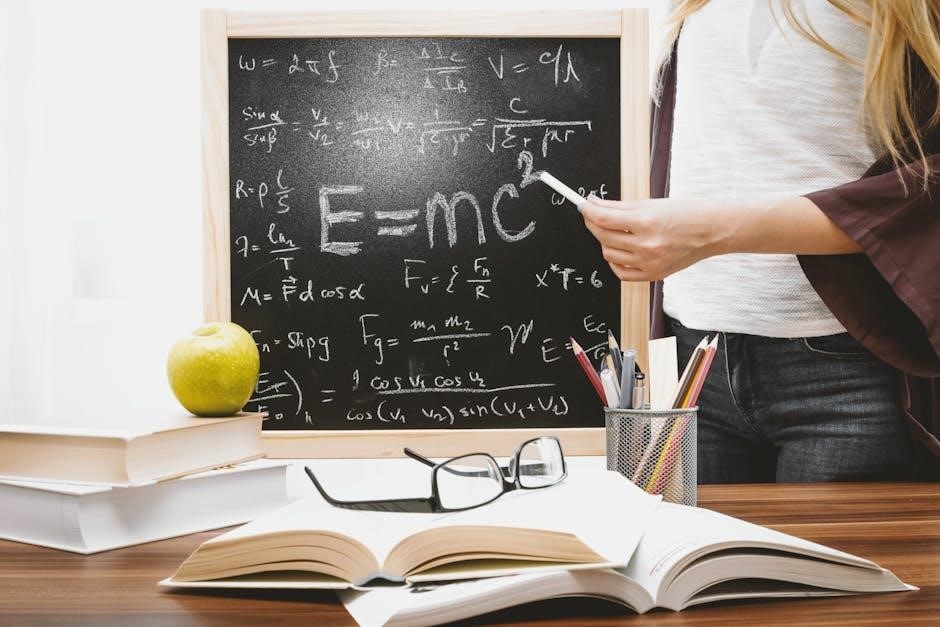The equation of state describes how pressure, volume, and temperature interact. It is essential in thermodynamics and fluid dynamics for analyzing material behavior and properties.
1.1 Definition and Importance
The equation of state is a mathematical relationship describing how pressure, volume, and temperature of a substance are interrelated. It is fundamental in understanding the thermodynamic behavior of gases, liquids, and solids. The EOS is crucial for predicting material properties under various conditions, such as extreme temperatures or pressures. Its importance lies in its ability to model real-world systems, from fluid dynamics to materials science. Accurate EOS formulations enable precise calculations in engineering and scientific applications, making it indispensable for designing efficient technologies and understanding complex physical phenomena. Without it, analyzing and predicting system behavior would be highly challenging, if not impossible.
1.2 Historical Background
The concept of the equation of state traces back to early studies of gas behavior. In 1662, Robert Boyle discovered the relationship between pressure and volume at constant temperature, leading to Boyle’s Law. Later, in 1787, Jacques Charles explored the relationship between volume and temperature, forming the basis for the ideal gas law. The development of more accurate equations for real gases began in the 19th century, with contributions from Johannes van der Waals, who introduced the van der Waals equation in 1873. This marked a significant milestone, as it accounted for molecular interactions and deviations from ideal behavior. These historical advancements laid the foundation for modern equations of state, enabling precise modeling of complex systems across various fields.

Key Components of the Equation of State
The equation of state involves pressure (P), volume (V), and temperature (T), describing how these variables interrelate in a system, forming the basis for thermodynamic analysis and material behavior modeling.
2.1 Pressure (P)
Pressure (P) is a fundamental variable in the equation of state, representing the force exerted per unit area on the surface of a substance. It is typically measured in units such as pascals (Pa) or atmospheres (atm). Pressure plays a critical role in describing the thermodynamic state of a system, influencing how gases, liquids, and solids behave under varying conditions. In the context of the equation of state, pressure interacts with volume (V) and temperature (T) to define the physical properties of a material; Understanding pressure is essential for predicting how substances respond to changes in their environment, making it a cornerstone of thermodynamic analysis and engineering applications. Its accurate measurement and modeling are vital for both theoretical and practical studies.
2.2 Volume (V)
Volume (V) is a critical parameter in the equation of state, representing the spatial extent of a substance. It is typically measured in units such as cubic meters (m³) or liters (L). Volume plays a central role in thermodynamic equations, as it interacts with pressure (P) and temperature (T) to determine the state of a system. Changes in volume can significantly affect the behavior of gases, liquids, and solids, particularly under varying external conditions. For gases, volume is inversely related to pressure at constant temperature, while for liquids and solids, it remains relatively constant. Accurate modeling of volume is essential for understanding material properties and phase transitions, making it a cornerstone of thermodynamic studies and practical applications.
2.3 Temperature (T)
Temperature (T) is a fundamental parameter in the equation of state, measuring the thermal energy of a system. Expressed in units like Kelvin (K) or Celsius (°C), it influences molecular motion and interactions. Temperature determines phase changes, such as melting or boiling, and affects the relationship between pressure and volume. In gases, higher temperatures increase kinetic energy, leading to higher pressures if volume is constant. For solids and liquids, temperature changes can alter their structure and properties. Understanding temperature’s role is vital for modeling real-world systems, as it directly impacts the behavior of substances across various conditions and applications in fields like thermodynamics and materials science.

Types of Equations of State
Equations of state are categorized into ideal gas, real gas, and tabulated equations. Each type describes pressure-volume-temperature relationships under different conditions and complexities for various substances.
3.1 Ideal Gas Equation
The ideal gas equation, PV = nRT, is a fundamental relationship describing the behavior of ideal gases. It relates pressure (P), volume (V), temperature (T), and the number of moles of gas (n), with R as the universal gas constant. This equation assumes gases consist of point particles with no intermolecular forces and negligible volume compared to container size. It is a simplification but highly effective for gases under low pressure and high temperature. The ideal gas law serves as the foundation for more complex equations of state and is widely used in chemistry, physics, and engineering. Despite its simplicity, it accurately predicts gas behavior in many practical scenarios, making it a cornerstone of thermodynamics.
3.2 Real Gas Equations
Real gas equations account for the behavior of gases under conditions where the ideal gas law is insufficient, such as at high pressures and low temperatures. These equations correct for factors like intermolecular forces and the finite volume of gas molecules. Common examples include the van der Waals equation, the Redlich-Kwong equation, and the virial equation of state. Each equation introduces additional parameters to better describe real gas behavior. For instance, the van der Waals equation includes terms for intermolecular attraction and molecular volume. Real gas equations are critical in chemical engineering and industrial processes where accurate predictions of gas behavior are essential. They provide a more realistic framework for understanding and calculating thermodynamic properties under extreme conditions.
3.3 Tabulated Equations of State
Tabulated equations of state are empirical models derived from extensive experimental data. They provide detailed thermodynamic properties for substances under various conditions by interpolating within precomputed tables. These tables are often constructed from measurements of pressure, volume, and temperature for specific materials. Tabulated equations are particularly useful for substances with complex phase behavior or when theoretical models are inadequate. They are widely used in materials science and engineering applications where precise property predictions are critical. Many tabulated equations of state are available in PDF resources, offering comprehensive datasets for researchers and practitioners. These resources often include instructions for interpolation and application in real-world scenarios.

Applications of the Equation of State
The equation of state is crucial in engine performance modeling, chemical processing, and astrophysical simulations, providing insights into material behavior under varying conditions for precise calculations and predictions.
4.1 Thermodynamics
The equation of state is fundamental in thermodynamics, enabling the calculation of energy, enthalpy, and entropy for substances under various conditions. It is essential for analyzing phase changes, heat transfer, and work interactions in systems. By relating pressure, volume, and temperature, it provides a framework for understanding ideal and real gas behavior. This is critical in designing heat engines, refrigeration systems, and power generation processes. The equation of state also aids in predicting the thermodynamic properties of fluids and solids, ensuring accurate simulations and optimizations in engineering applications.
4;2 Fluid Dynamics
In fluid dynamics, the equation of state is crucial for understanding the behavior of gases and liquids under varying conditions. It helps model compressible and incompressible flows, enabling predictions of pressure waves and shock waves. This is vital in aerodynamics and hydrodynamics for designing aircraft, pipelines, and turbines. The equation of state determines how density changes with pressure and temperature, which is essential for simulating high-velocity flows and supersonic phenomena. Accurate equations of state ensure precise calculations in fluid flow simulations, making them indispensable in engineering and research for optimizing performance and safety.
4.3 Materials Science
In materials science, the equation of state provides insights into how materials respond to changes in pressure, volume, and temperature. It is crucial for understanding phase transitions, such as melting or vaporization, and for studying crystal structures under extreme conditions. This knowledge aids in designing advanced materials with tailored properties, such as high-strength alloys or semiconductors. Additionally, the equation of state helps predict material behavior during manufacturing processes, ensuring optimal performance and durability. Its application extends to nanotechnology and composite materials, where precise control over material properties is essential. By linking thermodynamic variables, it enables the creation of innovative materials for diverse industrial and technological applications.

Derivation of the Equation of State
The derivation involves theoretical and experimental approaches. It uses statistical mechanics and algebra to link pressure, volume, and temperature, ensuring accurate predictions of material behavior.
5.1 Theoretical Derivation
The theoretical derivation of the equation of state relies on statistical mechanics and thermodynamic principles. It begins with the kinetic theory of gases, where molecular motion and interactions are analyzed. By applying Maxwell-Boltzmann distributions, scientists derive relationships between pressure, volume, and temperature. For ideal gases, the derivation simplifies, assuming no intermolecular forces. However, for real gases, additional terms account for particle interactions and density effects. Theoretical derivations often involve solving complex integral equations or using virial expansions. These methods provide a foundation for understanding how gases behave under varying conditions, linking microscopic properties to macroscopic observables. This approach is crucial for predicting material behavior in diverse scientific and engineering applications.
5.2 Experimental Derivation
Experimental derivation of the equation of state involves precise measurements of pressure, volume, and temperature for a given substance. Researchers use advanced techniques such as adiabatic calorimetry or shock wave experiments to gather data. These experiments are conducted under controlled conditions to observe how materials behave under varying thermodynamic states. The data is then analyzed to formulate empirical relationships, which are validated against theoretical models. Experimental methods are crucial for understanding real-world deviations from ideal behavior, especially for complex materials. Accurate measurements ensure the derived equation of state reflects true physical interactions, making it reliable for practical applications in fields like engineering and materials science.

Limitations and Challenges
The equation of state faces challenges like complexity in real gas behavior and experimental difficulties in measuring precise thermodynamic properties under extreme conditions.
6.1 Complexity of Real Gases
Real gases exhibit complex behavior due to intermolecular forces and non-ideal interactions, making their equations of state highly non-linear and challenging to model. Unlike ideal gases, real gases do not follow simple relationships, requiring advanced theoretical frameworks. Experimental data often shows deviations from ideal behavior, particularly at high pressures or low temperatures. These complexities demand sophisticated equations, such as virial expansions or cubic equations, to accurately predict thermodynamic properties. The intricate molecular interactions and phase changes further complicate the derivation of precise equations of state, limiting their applicability across diverse physical conditions. This challenge is a significant focus in thermodynamics and materials science.

6.2 Experimental Difficulties
Experimental derivation of the equation of state faces significant challenges, particularly under extreme conditions like high pressures or low temperatures. Accurate measurements of pressure, volume, and temperature are difficult due to equipment limitations and material properties. Real gases exhibit non-linear behavior, complicating data interpretation. Additionally, achieving equilibrium states for precise measurements is time-consuming and requires advanced techniques. The presence of phase transitions further adds complexity, as small deviations can lead to significant errors. Experimental noise and human error also pose challenges, making it difficult to obtain reliable data. These factors highlight the need for robust methodologies and sophisticated instrumentation to ensure accurate results in deriving equations of state.

Equation of State in PDF Format
PDF resources on the equation of state provide detailed explanations of its principles, applications, and derivations. These documents are essential for understanding thermodynamic relationships and material behavior.
7.1 Availability of PDF Resources
PDF resources on the equation of state are widely available online, offering comprehensive insights into its principles and applications. Academic platforms, institutional repositories, and online libraries provide access to textbooks, research papers, and study guides. These documents are often free or require minimal subscription fees, making them accessible to students and professionals. Many universities and research institutions publish PDF materials, ensuring a diverse range of perspectives and depths of coverage. Additionally, websites like arXiv and Google Scholar host numerous PDFs on the topic, catering to both introductory and advanced learners. This widespread availability facilitates easy access to knowledge on the equation of state.
7.2 Key Topics Covered in PDFs
PDFs on the equation of state typically cover foundational concepts, including its definition and significance in thermodynamics. They often detail the historical development of the equation and its evolution. Practical applications, such as fluid dynamics and materials science, are frequently highlighted. Many resources include sections on ideal gas laws, real gas corrections, and tabulated equations for complex systems. Advanced topics like phase transitions and equation derivation methods are also addressed. Additionally, PDFs often provide case studies, graphical illustrations, and example problems to aid understanding. Some resources even explore modern computational approaches and experimental techniques for determining equations of state, making them invaluable for both students and researchers.
The equation of state is a fundamental tool in understanding the behavior of matter under various conditions. It bridges thermodynamics, fluid dynamics, and materials science, providing insights into how substances respond to changes in pressure, volume, and temperature. PDF resources offer comprehensive guides, from basic principles to advanced applications, making them invaluable for both students and professionals. While challenges like real gas complexity and experimental limitations exist, the equation of state remains a cornerstone of modern physics and engineering. Continued research and educational resources ensure its relevance and accessibility in advancing our understanding of material properties and behavior.
